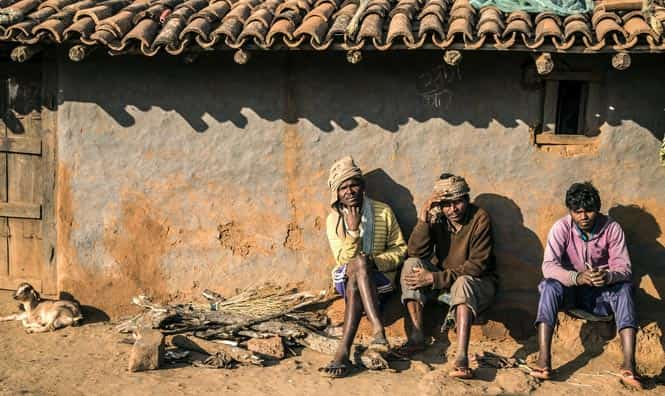Let's start this journey from the eastern state of Jharkhand - "The land of the forest" which is also the home to our Asur Tribe. Their population stands at 7783 which is 0.13 % of total Jharkhand's population leading them to be one of the vulnerable groups of India. It was not until 2014 when they were first listed under Scheduled Tribes.
Image Source: forwardpress.in
Who are they?
The Asur's have always been the recipients of controversies due to their religious belief. They consider themselves as the descendant of Mahishasur and share empathy with him by mourning his death during the nine days of Navratri. On the eve of Sohrai that coincides with Diwali, people apply oil on their chest, nose and naval area and eat cucumber. The oil symbolizes the blood gushing out of their ancestor Mahishasur when he was killed and the cucumber is a symbol of kaleji(liver) of the killer. They don't follow any violent approach towards the acceptance of their belief but they do feel the need to live unapologetically. Many Asur's have converted to Christianity as they believe that a new faith may protect them from majoritarian backlash.
Tradition and customs
They follow Animistic form of belief that has led them to have harmonious practices towards nature.They believe in witchcraft and worship their deities such as Singbhonga, Dharti Mata and Duari. They perform sacrificial rites of goat,chicken,duck and egg to impress their deities. They don't drink cow's milk. Instead they leave it for the calves so that when they grow up they are stronger and can be used in the fields. They do savour the finest produce of rice beer that has paved way into their traditions.
The Asur people follow monogamy except in the case of infertility and widow hood.
Widow remarriage is allowed and endogamy is rigorously followed. If someone fails to follow these rules they are thrown out of the tribe and considered as outcasts until they repay with seven feasts to the community members. In their marriage they follow the custom of bride price where pig is considered to be essential along with cash and clothes. The men love to sport Gamcha(cotton towel) tied on their head and Dhoti. The women originally wore only Sari but now they wear blouse and saya as well. Having kids before marriage is not stigmatized amongst them.
Their funeral is one of a kind and segregated into three rituals. One for the newborn babies, the other for people with untimely death such as accident,suicide etc and for natural death. The souls of people with untimely death is considered evil while those of natural death is worshipped. Their food majorly consists rice ,bird and flesh. Asur people love to paint the walls on the outside. They live in mud thatched houses with wooden doors and straw roofs with a space for cattle and deity worship. They observe Asur Pooja twice a year,once during the month of Phagun and other during Dussehra. The rituals are only performed by men and women participate in the celebration by performing Asura dance.
What do they do?
The Asur's were once the greatest iron smelters. It was said that their iron never rusts and there is also a popular theory that Magadha empire was supplied weaponry by Asur people. Even the Magadha edicts have never seen to be rusted.
But now its a different story.
There is hardly any iron smelting unit left in their village. During British Raj the Asur people were displaced and cut off from their roots and the legislations of Indian Forest Act 1865 restricted them from using forest-based products. They needed forest wood to produce charcoal for their traditional process of smelting of iron. Even after the independence they were forced to adopt agrarian lifestyle The youth has started working in bauxite mines since their utensils and weapons don't earn them much. Young people are moving to the city for better opportunities and to save themselves from the identity crisis that comes with their surname. The older generation has slowly forgotten their own art.
How to preserve them?
The first and the foremost step that needs to be taken is liberalization of thoughts and belief amongst people so that no tribe has to be ashamed of their roots and name. Instill in youth the feeling of gratitude towards their rich and unique culture.
UNESCO has recognized Asuri language in their UNESCO Interactive Atlas of the World's Languages in Danger. For the purpose of the revival of language radio programmes are aired to transmit local news and songs.
We need to recognize that our diverse country is built of various ideologies, beliefs and customs that might not be synonymous with everyone. Beliefs are just beliefs ,they do not need to be proven or accepted by majority for their safe existence.
"This is the land of our birth. For us this is heaven." -Baiga India


This comment has been removed by the author.
ReplyDeleteThis is intrinsically a well researched article which delves us into our traditional tribal culture. It's an amazing piece of work and I look forward to many more blogs on equally interesting topics which takes us back to our own roots. Keep up the good work yashasvi!
DeleteThanks Shreyonshi ❤️ Will sure do
DeleteThank you
ReplyDelete